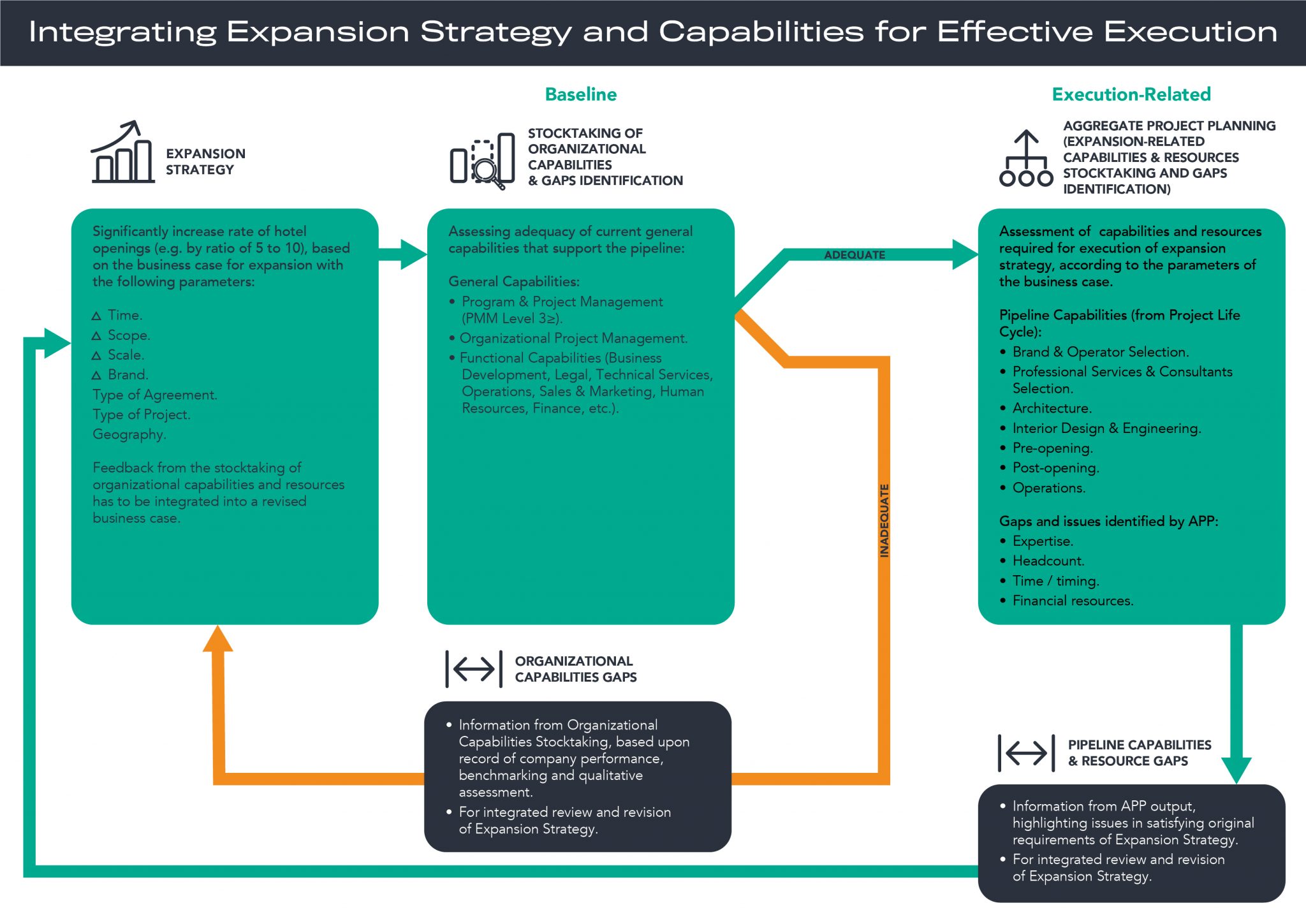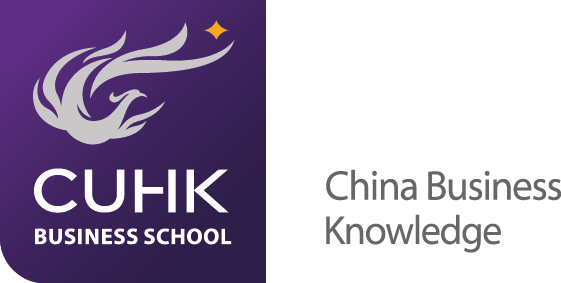Hotel Expansions: Bridging the Divide between Ambition and Ability
• 9 mins read
An industry-wide disconnect between expansion ambitions and organisational capabilities is causing hotel growth strategies to fail
The hospitality industry has suffered from the tendency to announce huge scale-up visions in five-year plans, attracting media attention, adulation and hype, while these are seldom accompanied by plans to develop the resources and capabilities needed to executive on these grand strategies. This suggests there is a disconnect between the market domination ambitions from the organisational capabilities critical for achieving them. Senior leadership often fails to see the connection between ambitions and ability to execute.
The gap is often exacerbated because the strategisers do not consider the development of the right type and level of competencies and capabilities an integral part of strategy. Ambitious market strategies are considered symbolic of leadership genius, while organisational resources and competencies are deemed to be pedestrian at best and irrelevant at its worst. Consider the recent example of Oyo Rooms, an Indian hospitality chain, over the period of 2013 to 2019, as a vivid illustration of how ignoring resources and competencies could lead to disaster.
“Typically, hospitality organisations are not keen on assessing resources and capabilities, as senior executives often do not appreciate the importance of their role.”
Mr. Gert Noordzy & Mr. Oscar Hauptman
Founded in 2013, Oyo Rooms attracted the attention of regional and global media alike with headlines touting a company that is set to disrupt the global hotel industry. In 2019, Oyo Rooms was ranked as the world’s third largest hotel company by number of rooms, up from eighth in 2018. Unfortunately, unraveling of the start-up online aggregator cum franchisor of budget hotels started several years earlier. Reports emerged that the company was slashing footprint and headcount as well as other troubles at the start-up . It should be noted that the dynamics of the current pandemic have been explicitly excluded from our data and analysis, as these are proving to be disruptive and challenging to the hospitality industry for very different reasons. At the same time, COVID-19 has only accelerated the decline of Oyo Rooms.
Problems at Troubled Start-Up
Typically, as start-ups scale up and operational plans are executed, core financial metrics improve towards profitability. In contrast, the exact opposite has happened to Oyo Rooms. The company reported financial losses of US$67 million in 2016, US$42 million in 2017 and US$52 million in 2018. Losses increased to US$335 million in 2019, while internal projections showed it may not make a profit in India and China until 2022. Our extensive desktop review of online coverage of challenges and issues over the period of 2016 to2019 illustrates a multitude of problems. These multi-dimensional issues include soaring valuation and lack of profits, regulatory and governance concerns, massive layoffs (contradicting the scale-up plan for global market domination), disgruntled hotel and industry partners, poor customer experiences, failure to deliver core brand promises and facing legal actions by numerous powerful stakeholders, are clearly symptomatic of deep-seated systemic causes.
In the hotels industry, many companies suffer from a disconnect between expansion ambitions and organisational capabilities needed to achieve them. A study of what causes potentially effective strategies to fail delivering desired outcomes indicated that over 60 percent of firms often struggled to bridge the gap between strategy formulation and implementation.
In Oyo Rooms’ case, the disconnect came despite the support of two mentor-investors (Masayoshi Son’s US$100 billion Vision Fund and Peter Thiel’s Fellowship programme) behind the Oyo Rooms’ Founder and CEO – Ritesh Aggarwal. With total commitment to driving the strategy of global monopoly, and total confidence in having the secret recipe for mega success, the mentor-investors provided support to OYO Rooms, who was very receptive of this ambitious vision and ready to execute it. These mentor-investors were the instigators for and actively pushed the CEO to go for global domination.

In spite of the open checkbook from Soft Bank’s Vision Fund, the leadership of the company lacked the required deep and intuitive conviction of connecting strategic planning with capabilities and resources needed to execute it. Oyo Rooms’ CEO, with explicit support of his mentor-investors, simply failed to resource and scale up the company’s organisational capabilities.
Why such confusion and such lack of preparedness for the challenges at hand? Why such blind devotion to extremely ambitious expansion goals and such disregard, almost disrespect, for knowledge, know-how and basic business logic? What about the simple rule that new initiatives, such as global market expansion, require resource mobilisation, a war chest, and sufficient headcount of the right people at the right time in the right place? And finally, what happened to the basic intuition that financial resources do take time to translate into improved organizational capabilities and core competencies through training and integration with the organisation and its stakeholders?
Strategy and Resources/Capabilities: The Chicken or the Egg?
Nobody disputes the need for clarity of goals and well-designed competitive strategy. Michael Porter and numerous strategy and competitiveness scholars have articulated the elements of effective strategy and the process of developing it. But as C.K. Prahalad and Gary Hamel illustrated in their research and its extensive impact on business practices, a complex and multinational organisation cannot rely on devising a well-crafted competitive strategy alone to ensure success — it must have the core competencies that could enable turning this strategy into reality. The dilemma of whether competitive strategy defines the required core competencies, resources and capabilities, or the organisational core competencies define the limits of competitive strategy can be seen as a “chicken-or-the-egg” conundrum.
To resolve this conundrum, one needs to approach the issue through a Resource-based View (RBV), which prescribes that the competitiveness of a business is determined by the quality of the resources it develops, controls and masters. RVB is a practical strategic framework effective for determining the strategic resources a firm can exploit to achieve sustainable competitive advantage. RVB resolves the chicken or the egg conundrum by viewing strategy and capabilities as the proverbial two sides of the same coin of competitiveness, and must be addressed in an integrated fashion, simultaneously. In other words, there is a tight interdependence and a strong requirement for synchronous development of competitive strategy and the resources and capabilities supporting its execution.
While the need for synchronous development of strategy and capabilities seems obvious, the typical ambitions of many “blue chip” hospitality leaders dictate uber-scale-up, following a popular narrative of “follow your dream” and “be passionate about your goals”. This is done without much attention to designing the strategy of developing and securing resources to scale-up the overall organisation, each function, and every region, as required by the expansion business case. Typically, hospitality organisations are not keen on assessing resources and capabilities, as senior executives often do not appreciate the importance of their role. Scaling-up of resources and capabilities is often done as an afterthought and the lack of ready-to-exploit resources and capabilities results in doomed to fail firefighting during execution.
We are convinced that this disconnect could be naturally resolved through a Program & Project Management (PPM) methodology, more specifically, anchoring the development pipeline in the framework of Aggregate Project Planning (APP). This means developing resources and capabilities in synchronicity with the requirements of the business development pipeline.
Integrating Expansion Strategy and Capabilities
As illustrated in the figure below, the framework provides the foundation for a prudent and focused expansion strategy implementation: on the strategy side, it is driven by a well-defined business case, anchored in specific parameters of an expansion. On the execution side, the two-step analysis imposes a rigorous reality test of strategy’s feasibility and risk, and informs the business case about the gaps and hurdles that must be addressed to give the strategy a prudent level of confidence in its success.

First, we must recognize Project Management as a general capability, a given baseline when initiating, planning and executing global strategic initiatives. We insist that a hotel company that manages complex and large scale and scope strategic initiatives must have an adequate level of Project Management Maturity (PMM). If not, this gap would compound the inherent challenges and must be addressed as becomes the first priority.
Second, we apply the APP tools to ensure that the collective set of projects in the development pipeline would accomplish the objectives of the business case and builds on organisational capabilities needed for ongoing success. Starting with the top-down flow, APP uses expansion strategy business case parameters, such as scale, scope and location, to identify pipeline capabilities and resources required down to the individual project level. Then, bottom-up, from individual properties to regional and finally to corporate level, APP provides the information from the execution side to the expansion strategy side about the gaps in capabilities and resources, as they appear in the most resource efficient implementation plan, over time. These gaps must be addressed by modifications to expansion strategy and/or development of capabilities and reallocation and rescheduling the resources. And again, money cannot compensate for compressed execution schedule, as training and learning, the “soft resources”, take time.
Integrating Expansion Strategy and Capabilities for Effective Execution
To conclude, opening new and onboarding existing properties on large scale is a massive undertaking, which requires any hospitality company to scale-up organisational capabilities and resource to execute. Plans have to be designed, resources allocated, and a war chest to support these resources must be defined financially with relevant experts and major shareholders.
We hope this article would set in motion new insights and adaptations to rapidly and drastically changing reality Going forward, it is necessary to adapt the illustrated methodology to the much more challenging predicament facing the hospitality industry with post-pandemic realignment. How should hoteliers rightsise and scale down to survive and thrive again?
An abridged version of this article was previously published on Hotel News Now.
Gert Noordzy is Adjunct Assistant Professor at the School of Hospitality and Tourism Management at The Chinese University of Hong Kong (CUHK) Business School. He is a hotel opening specialist and organisational project management expert. He is also managing director of Northside Consulting, a boutique firm specializing in the tactical and strategic aspects of hotel opening processes, and member of the International Society of Hospitality Consultants. Gert is the author of Project Management of Hotel Opening Processes. He can be reached gert.noordzy@northside-consulting.com.
Oscar Hauptman is an expert in project, program and innovation management, with a PhD in Management and Technology Innovation from Massachusetts Institute of Technology. Oscar has taught as faculty member at Harvard Business School.








